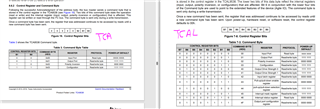Other Parts Discussed in Thread: TCA6416, TCA9538,
Tool/software:
I'm currently selecting an I/O expander IC. Are there any specific differences in usage?
Do they provide Linux drivers?
This thread has been locked.
If you have a related question, please click the "Ask a related question" button in the top right corner. The newly created question will be automatically linked to this question.
Hi Keng,
I am taking an answer from a previous thread:
The gpio-pca953x driver is part of the Linux kernel; its compatible ID for this device is "ti,tca6416".
The configuration of the DeviceTree bindings depends on your hardware and how you want to use it. For details, see the kernel documentation: gpio.txt, gpio-pca95xx.yaml.
The compatible TI ID should be "ti, tca9538"
We do not have linux drivers on the product page, but external source code above should help.
The main difference between TCA and TCAL is the voltage range changes, data rate, and agile I/O registers.
TCA vs. TCAL
1.65V to 5.5V --> 1.08V to 3.6V
400kHz --> 1 MHz
register map differences:

Regards,
Tyler
Are there any issues when using the TCAL9538 with a Linux driver?
Since the TCAL9538 has many more registers compared to the TCA9538,
could that cause compatibility problems?
Alternatively, could you recommend an IC with similar specifications to the TCAL9538 that has a well-supported Linux driver?
The TCAL registers are backwards compatible with the TCA registers, so the driver will work, but only for the common features.
If you do not need the additional features of the TCAL, just use the TCA. Otherwise, you have to extend that driver, or write your own.
Hi Keng,
The TCAL9538 should use the same framework as the TCA device.
TCAL can be operated to 1 MHz, and has extended register set.
If you need access to the additional registers given in the TCAL device, you would need to extend the capability of the Linux driver per Clemens' comment.
Regards,
Tyler